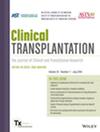Secular Trends in Development of End-Stage Renal Disease Following Liver Transplantation
Abstract
Background
Renal dysfunction is common among liver transplant candidates and can resolve, persist, or develop de novo following liver transplantation (LT). In light of the 2017 policy changes to simultaneous liver-kidney transplant and the post-LT kidney transplant safety net eligibility, we evaluated risk factors for and change in the incidence of post-LT renal dysfunction.
Methods
Using SRTR data for adult deceased-donor liver-only transplant recipients 2010–2022, we evaluated secular trends in and risk factors for the development of post-LT ESRD at 1 year and overall using multivariable logistic and Cox regression. We compared observed versus expected incidence of ESRD at 1-year post-LT using weighting by odds.
Results
Among 77 565 LT recipients, 6032 (7.8%) developed ESRD during the study period, of whom 2354 (39.0%) developed ESRD within the first year after LT. In a multivariable model, diabetes (aOR 1.63, 95% CI 1.48–1.79, p < 0.001), pre-LT eGFR (aOR 0.97 per unit, 95% CI 0.97–0.97, p < 0.001), and MELD category remained independently associated with ESRD within 1-year post-LT. Odds of ESRD by 1 year post-LT were 47% higher than expected post-2017 after accounting for changes in donor and recipient characteristics.
Conclusions
The rising 1-year post-LT ESRD risk highlights the need to reassess safety net eligibility beyond 1 year and prioritize counseling on risk minimization, including post-transplant diabetes management and potential adjustments to immunosuppression protocols to improve outcomes.

 求助内容:
求助内容: 应助结果提醒方式:
应助结果提醒方式:


